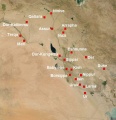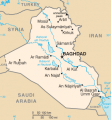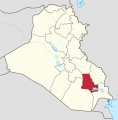Kisurra
Da Ufopedia.
(→References) |
(→Galleria immagini) |
||
| (29 revisioni intermedie non mostrate.) | |||
| Riga 1: | Riga 1: | ||
| - | '''Kisurra''' ( | + | '''Kisurra''' (nel sito moderno di '''Tell Abu Hatab''' in [[Iraq]]) era un'antica città [[Sumeri|sumerica]] situata sulla riva ovest del medio corso del fiume [[Eufrates]], a nord di [[Shuruppak]]. |
| - | Kissura | + | La maggiore divinità di Kissura era [[Ninurta]]. Più tardi Kisurra divenne il centro principale del culto mesopotamico di [[Ishara]], benchè si sia pensato che essa fosse stata adorata su di un'ampia area da Siriani, Cananiti, e Ittiti [1]. |
| - | == | + | ==Storia== |
| - | Kissura | + | Kissura fu fondata nel 2700 aC circa, durante il [[Periodo proto-dinastico II]]. |
| - | + | L'estremità sud del canale Isinnitum venne collegato all'Eufrate a Kisurra [2]. La città perdurò come centro di commercio e trasporto tra l'impero di [[Akkad]] e parte degli imperi [[Babilonia|babilonesi]], ma nel periodo di [[Hammurabi]] (c.1800 aC) [3] i testi cuneiformi e gli scavi mostrano che Kisurra declinò. | |
| - | ''' | + | '''Lista dinastica dei re di Kisurra:''' |
| - | Itur Szamasz c.2138 | + | Itur Szamasz c.2138 aC costruì la 'barriera di Hadi-el', le mura di Kisurra [4]. |
| - | Manabaltiel c.2123 | + | Manabaltiel c.2123 aC |
| - | + | Nel 2113 aC la città di Kisurra perse la sua indipendenza, per finire cotto l'amministrazione dei re della città di [[Ur]] | |
| - | Szarrasyurrm c.2108 | + | Szarrasyurrm c.2108 aC |
| - | Ubaya | + | Ubaya c.2093 aC |
| - | Zikrum | + | Zikrum c.2078 aC |
| - | + | Nell'anno 2048 aC il re [[Bur-Sin]] di [[Ur]] rimosse il re di Kisurra | |
| - | Ibbi Szamasz 2030-2013 | + | Ibbi Szamasz 2030-2013 aC |
| - | + | Il re Ur Nammu di Ur rimosse il re Ibbi Shamash dal trono nel 2013 aC [5] | |
| - | == | + | ==Archeologia== |
| - | + | Gli archeologi tedechi hanno trovato molte tavolette [[scrittura cuneiforme|cuneiformi]] a Tell Abu Hatab. | |
| + | ==Galleria immagini== | ||
| + | <gallery> | ||
| + | Immagine:Meso2mil.JPG | ||
| + | Immagine:Iraq_map.png | ||
| + | Immagine:Dhi_Qar_in_Iraq_svg.png | ||
| + | Immagine:Map_of_OIC.png | ||
| + | Immagine:Flag_of_Iraq_svg.png | ||
| + | Immagine:Flag of OIC.png | ||
| + | Immagine:Flag_of_the_United_Nations_svg.png | ||
| + | </gallery> | ||
| - | == | + | ==Voci correlate== |
| - | [[ | + | *[[Sumeri]] |
| - | == | + | ==Note== |
1^ [http://www.themystica.com/mythical-folk/~articles/i/isara.html Isara] | 1^ [http://www.themystica.com/mythical-folk/~articles/i/isara.html Isara] | ||
| - | == | + | 2^ [http://www.jameswbell.com/geog001sumerianwaterways.html Sumerian Waterways] |
| + | |||
| + | 3^ Rogers, Robert William (1915) A History of Babylonia and Assyria. The Abingdon Press pag.435 | ||
| + | |||
| + | 4^ [http://net.bible.org/dictionary.php?dict=dictionaries&word=Babylon NETBible: Babylon] | ||
| + | |||
| + | 5^ Zimmerer, Neil (2003) The Chronology of Genesis: A Complete History of the Nefilim. Adventures Unlimited Press ISBN 1931882223 pag.30 | ||
| + | |||
| + | ==Collegamenti esterni== | ||
*[http://www.klinopis.cz/utf/utf/obtexttype.php?origin=Kisura&type=document Old Babylonian text Corpus at Freiburger Altorientalische studies - in german] | *[http://www.klinopis.cz/utf/utf/obtexttype.php?origin=Kisura&type=document Old Babylonian text Corpus at Freiburger Altorientalische studies - in german] | ||
*[http://cdli.ucla.edu/tools/yearnames/E_GLOSSARINDEX/R849.htm Kisurra related Year Names at CDLI] | *[http://cdli.ucla.edu/tools/yearnames/E_GLOSSARINDEX/R849.htm Kisurra related Year Names at CDLI] | ||
| + | |||
| + | http://it.wikipedia.org/wiki/Governatorato_di_Dhi_Qar | ||
[[Category:Città sumere]] | [[Category:Città sumere]] | ||
Versione attuale delle 07:43, 14 apr 2016
Kisurra (nel sito moderno di Tell Abu Hatab in Iraq) era un'antica città sumerica situata sulla riva ovest del medio corso del fiume Eufrates, a nord di Shuruppak.
La maggiore divinità di Kissura era Ninurta. Più tardi Kisurra divenne il centro principale del culto mesopotamico di Ishara, benchè si sia pensato che essa fosse stata adorata su di un'ampia area da Siriani, Cananiti, e Ittiti [1].
Indice |
Storia
Kissura fu fondata nel 2700 aC circa, durante il Periodo proto-dinastico II.
L'estremità sud del canale Isinnitum venne collegato all'Eufrate a Kisurra [2]. La città perdurò come centro di commercio e trasporto tra l'impero di Akkad e parte degli imperi babilonesi, ma nel periodo di Hammurabi (c.1800 aC) [3] i testi cuneiformi e gli scavi mostrano che Kisurra declinò.
Lista dinastica dei re di Kisurra:
Itur Szamasz c.2138 aC costruì la 'barriera di Hadi-el', le mura di Kisurra [4].
Manabaltiel c.2123 aC
Nel 2113 aC la città di Kisurra perse la sua indipendenza, per finire cotto l'amministrazione dei re della città di Ur
Szarrasyurrm c.2108 aC
Ubaya c.2093 aC
Zikrum c.2078 aC
Nell'anno 2048 aC il re Bur-Sin di Ur rimosse il re di Kisurra
Ibbi Szamasz 2030-2013 aC
Il re Ur Nammu di Ur rimosse il re Ibbi Shamash dal trono nel 2013 aC [5]
Archeologia
Gli archeologi tedechi hanno trovato molte tavolette cuneiformi a Tell Abu Hatab.
Galleria immagini
Voci correlate
Note
1^ Isara
3^ Rogers, Robert William (1915) A History of Babylonia and Assyria. The Abingdon Press pag.435
5^ Zimmerer, Neil (2003) The Chronology of Genesis: A Complete History of the Nefilim. Adventures Unlimited Press ISBN 1931882223 pag.30






